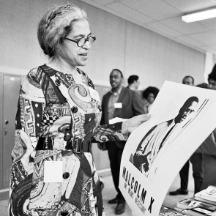Watching the new restoration, I recall being a twelve-year-old boy and accidently walking into the lobby and picking up literature that inspired dreams for my city and my country. As the film rolls, Richard Gordon Hatcher (who will be “my mayor” for eternity) opens the Convention in the newly constructed West Side High School with poet Amiri Baraka. Baraka starts by declaring the objectives of the 10,000-person gathering: “Firstly, the unity of Black people.”
The City Built on Sand
It was sweet to see so many budding and established activists from Max Robinson to Rosa Parks to Ron Dellums all sitting in the Cougar Den -- our gymnasium, with its orange and blue colors, turned into a historic gathering hall.The Convention was just one in a string of historic events that pollinated our industrial, working class, lakeshore town and made it an epicenter of Black progress and pride.
Hatcher’s historic win as mayor came in 1967, on the same day that Carl Stokes was elected mayor of Cleveland -- the first two Blacks with mandates to govern major American cities. In 1970, The Jackson Five – Gary’s homegrown wonder boys – had their first #1 hit, "I Want You Back." In 1971, Gary native Kellee Patterson became the first African American chosen as Miss Indiana and competed in the Miss America pageant. The Ms. Black America pageant came to the “City Built on Sand” in 1975, and again in 1976, the same year Ernest Lee Thomas, another native son, burst onto the national scene with his lead role on ABC’s “What’s Happening!!”
There was talk of Black sororities and fraternities and professional organizations creating a voluntary convention circuit, like the old involuntary chittlin’ circuit, that would include the Steel City, spurring development of Black-owned hotels and other services.
In 1981, Gary opened the Genesis Convention Center. While White Republican-controlled Indianapolis received monetary support from the Indiana legislature to build its convention center, Black Democratic-controlled Gary got nothing. "Our convention center is probably the only convention center in the U.S. that was built entirely with federal funds," Hatcher told me when we discussed whatever happened to the revolution in his ranch style home in 2005.
There was talk of Black sororities and fraternities and professional organizations creating a voluntary convention circuit, like the old involuntary chittlin’ circuit, that would include the Steel City, spurring development of Black-owned hotels and other services. But the promises went unfulfilled and our dream of turning Gary into a model city is a dream deferred. When Gary hosted the 50th Anniversary Miss USA pageant in 2001 and again in 2002 at the Genesis Center, the adjacent 14-story convention center hotel had closed having never turned a profit.
Mayor Hatcher summed up the revolution’s delay by explaining that his power was limited. The problem, he said, was that “all the major economic decisions in the city were being made in rooms where there were no Blacks at all. In the end, the economic decisions were far more powerful than the political decisions." I often share this quote with those who question how gentrification takes place in an era of Black mayors.
Economically, Gary struggled and continues to struggle. While the city has become the western gateway to the Indiana Dunes National Park, we’ve lost population. West Side High is the last of seven high schools operating in the city and in need of repair. A neighboring town that the state helped to incorporate for White families fleeing Hatcher’s “Black power” will soon be 50% Black.
Black Power: Its Wins and Losses
The vision of more Black political power, articulated by Hatcher and Baraka and so many other eloquent speakers in “Nationtime,” has become a reality. But looking back at this time capsule of a film, I’m also struck by how openly misogynistic and inaudibly homophobic our Black “liberators” were.








